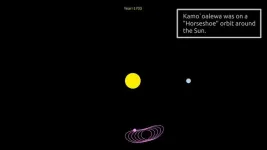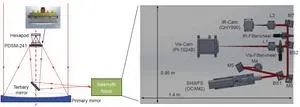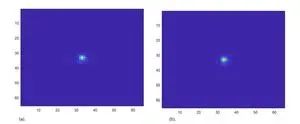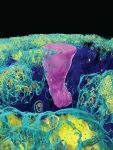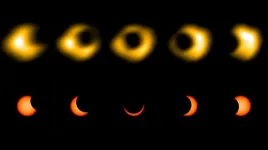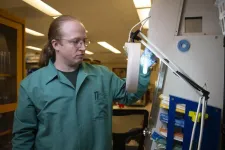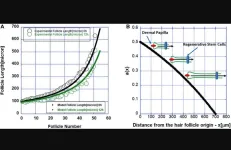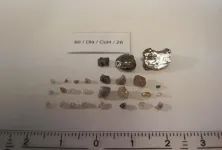(Press-News.org) In 2021, a team of University of Arizona astronomers suggested that a recently discovered near-Earth asteroid, Kamo`oalewa, could be a chunk of the moon. Two years after the striking discovery, another UArizona research group has found that a rare pathway could have enabled this to happen.
So far, only distant asteroids from beyond the orbit of Mars have been considered a source of near-Earth asteroids, said Renu Malhotra, Regents Professor of Planetary Sciences and a senior author on the paper.
"We are now establishing that the moon is a more likely source of Kamo`oalewa," Malhotra said.
The implication is that many more lunar fragments remain to be discovered among the near-Earth asteroid population. The study was published in the journal Communications Earth & Environment.
UArizona researchers decided to study Kamo`oalewa for two reasons. Kamo`oalewa is uncommon in that it is Earth's quasi-satellite, a term used for asteroids whose orbits are so Earth-like that they appear to orbit Earth even though they actually orbit the sun.
The other peculiar aspect of Kamo`oalewa is its longevity, said Jose Daniel Castro-Cisneros, the study's lead author and a graduate student in the Department of Physics. Kamo`oalewa is expected to remain as a companion of the Earth for millions of years, which is its remarkable feature, Castro-Cisneros said, unlike other known objects that stay in these very Earth-like orbits only for a few decades.
Aaron Rosengren, a former assistant professor in the Department of Aerospace and Mechanical Engineering, in the College of Engineering, was part of the study. Rosengren is now at the University of California, San Diego.
The 2021 study found that Kamo`oalewa's spectrum was unlike that of other near-Earth asteroids but matched most closely that of the moon. Based on this, the team hypothesized that the asteroid could have been ejected from the lunar surface as a result of a meteoroidal impact.
In the new study, Malhotra and her team wanted to determine the feasibility for a knocked-off piece of the moon to get into this quasi-satellite orbit – a phenomenon that is quite unlikely, Malhotra said. Moon fragments that have enough kinetic energy to escape the Earth-moon system also have too much energy to land in the Earth-like orbits of quasi-satellites, she said.
With numerical simulations that accurately account for the gravitational forces of all the solar system's planets, Malhotra's group found that some lucky lunar fragments could actually find their way to such orbits. Kamo`oalewa could be one of those fragments created during an impact on the moon in the past few million years, according to the study.
Throughout its history, the moon has been bombarded by asteroids, which is evident in the numerous impact craters preserved on its surface, explained Malhotra. Impact craters are created when asteroids or meteorites crash into the surface of a planet or the moon. Impacts cause lunar material to be ejected from the moon's surface, but most of that material usually falls back on the moon, she said.
Some of the ejected materials fall on Earth, and that's how we get meteorites from the moon, Malhotra said. But a small fraction could escape the gravity of both the moon and the Earth and end up orbiting around the sun like other near-Earth asteroids. Numerical simulation suggests that Kamo`oalewa could be one of even tinier fractions that gained entry into the hard-to-reach Earth's co-orbital space.
The study's findings could help understand more about near-Earth asteroids, which are considered a hazard to Earth, Malhotra said. More detailed studies of Kamo`oalewa and determining this asteroid's origin in a specific impact crater on the moon will provide useful insights on impact mechanics, she said.
In the future, Castro-Cisneros said the team is planning to identify the specific conditions that allowed the orbital pathway of Kamo`oalewa. The group is also aiming to work on determining Kamo`oalewa's exact age, he said.
"We looked at Kamo`oalewa's spectrum only because it was in an unusual orbit," Malhotra said. "If it had been a typical near-Earth asteroid, no one would have thought to find its spectrum and we wouldn't have known Kamo`oalewa could be a lunar fragment."
END
UArizona researchers probe how a piece of the moon became a near-Earth asteroid
An interesting pathway could have led the moon fragment to reach Earth's orbital space
2023-10-23
ELSE PRESS RELEASES FROM THIS DATE:
Rare lungs cells reveal another surprise with implications for cystic fibrosis
2023-10-23
A new study by University of Iowa researchers finds that rare lung cells known as pulmonary ionocytes facilitate the absorption of water and salt from the airway surface. This function is exactly the opposite of what was expected of these cells and may have implications for cystic fibrosis (CF) lung disease.
Five years ago, scientists reported the unexpected discovery that ionocytes—a cell type commonly found in fish gills and frog skin—are also present in the lining of human lungs and airways. These pulmonary ionocytes were particularly interesting to CF researchers because although they only account for about 1% of all the cells in the airway ...
New UCF project is harnessing virtual reality to teach quantum computing
2023-10-23
ORLANDO, Oct. 23, 2023 – Researchers from the University of Central Florida, University of Texas at Dallas and Vanderbilt University have received a three-year, $927,203 grant for advancing future quantum education by using virtual reality (VR) and machine learning to identify and address misconceptions regarding quantum information science (QIS).
The U.S. National Science Foundation-funded project started in August 2023 and leverages QubitVR, a quantum-education VR application previously developed ...
Major pathologic response to neoadjuvant pembrolizumab in advanced melanoma trial exceeds 50 percent
2023-10-23
In exploratory analyses of results from the SWOG S1801 trial in patients with stage III-IV resectable melanoma, researchers saw a major pathologic response in more than half of surgical specimens taken from patients who had been treated with neoadjuvant (pre-operative) pembrolizumab.
These and other results of the analyses are presented as a proffered paper (Abstract LBA48) at the European Society of Medical Oncology (ESMO) Congress 2023 in Madrid, Spain, on Monday, October 23, by Sapna P. Patel, MD, chair of the SWOG melanoma committee and associate professor of melanoma medical oncology at the University of Texas MD Anderson Cancer Center. Patel is principal investigator ...
NYSCF announces 2023 Class of NYSCF – Robertson Investigators
2023-10-23
The New York Stem Cell Foundation (NYSCF) today announced the 2023 class of NYSCF – Robertson Investigators, welcoming three outstanding stem cell researchers into the NYSCF Innovator community.
The NYSCF – Robertson Stem Cell Investigator Awards support promising early career scientists whose cutting-edge research holds the potential to accelerate treatments and cures through the NYSCF – Robertson Stem Cell Investigator Awards.
The awards provide unrestricted seed funding – $1.5 million over five years – for scientists who have established their own, ...
Researchers capture first images of a radio 'ring of fire' solar eclipse
2023-10-23
Researchers at New Jersey Institute of Technology’s Center for Solar-Terrestrial Research (NJIT-CSTR) have captured the Oct. 14 solar eclipse in a way never seen before — recording the first radio images of an annular eclipse’s famous “ring of fire” effect.
The eclipse was partially visible to much of the continental U.S. for several hours that Saturday, though the full “ring of fire” effect was only visible for less than five minutes, and only for those within its 125-mile-wide path of annularity.
However, the new observations of the radio Sun’s eclipse — ...
University of Montana leads $12.3 million contract to advance TB vaccine
2023-10-23
MISSOULA – The National Institutes of Health recently awarded a $12.3 million contract to the University of Montana to develop a novel vaccine adjuvant for use in a tuberculosis vaccine. Adjuvants are substances that boost the effectiveness of vaccines.
The five-year award went to UM’s Center for Translational Medicine and its partners. The contract is titled “Development of UM-1098: A Novel Synthetic Th17 Inducing Adjuvant and Delivery System.”
“The development and clinical evaluation of safe and effective ...
People who communicate more, show expertise are more likely to be seen as essential team members
2023-10-23
A new study sheds light on the vital role of communication and expertise within organizations, revealing their impact on group performance. Researchers examined how individuals become part of communication networks and the effect of selection processes on group performance. The study found that people who communicated more during training were more likely to be chosen as a central member of the network. In addition, teams that chose their central member performed as well as and often better than teams whose central member was randomly assigned.
The study, by researchers ...
Apoptotic cells may drive cell death in hair follicles during regression cycle
2023-10-23
“Revealing the stem cell niche self-renewal dynamics is important not only for understanding tissue homeostasis but also for understanding the initiation of cancer [7].”
BUFFALO, NY- October 23, 2023 – A new research paper was published in Oncotarget's Volume 14 on October 19, 2023, entitled, “Apoptotic cells may drive cell death in hair follicles during their regression cycle.”
Intravital microscopy in live mice has shown that the elimination of epithelial cells during hair follicle regression involves supra-basal cell differentiation and basal cell apoptosis through synergistic action of TGF-β (transforming ...
$3.6 million NIH award funds research to treat painful diabetic neuropathy
2023-10-23
COLUMBUS, Ohio – A $3.6 million award from the National Institutes of Health will allow neurosurgical, neurology and neuroscience researchers at The Ohio State University Wexner Medical Center and College of Medicine to test a novel diagnosis and treatment combination for painful diabetic neuropathy. The approach combines spinal cord stimulation with measurement of small fiber nerve activity using a patent-pending device called Detecting Early Neuropathy (DEN).
Diabetes is a growing health concern worldwide, ...
Superdeep diamonds provide a window on supercontinent growth
2023-10-23
Washington, DC—Diamonds contain evidence of the mantle rocks that helped buoy and grow the ancient supercontinent Gondwana from below, according to new research from a team of scientists led by Suzette Timmerman—formerly of the University of Alberta and now at the University of Bern—and including Carnegie’s Steven Shirey, Michael Walter, and Andrew Steele. Their findings, published in Nature, demonstrate that superdeep diamonds can provide a window through space and time into the supercontinent growth and formation ...
LAST 30 PRESS RELEASES:
Archaeologists use AI to create prehistoric video game
Mitochondria migrate toward the cell membrane in response to high glucose levels
Tiny viral switch offers hope against drug-resistant bacteria
Most parents aware of early peanut introduction guidelines, but confused about details
HPV vaccine can protect against severe lesions of the vulva and vagina
Virtual care provision and emergency department use among children and youth
Quadrivalent HPV vaccine and high-grade vulvovaginal lesions
Insights into dry eyes gained from stem cell-derived tear glands
Researchers identify 166 human pluripotent stem cell lines available for use in clinical applications
Europa Clipper instrument uniquely observed interstellar comet 3I/ATLAS
UN University Report challenges climate change as sole trigger of Syrian Civil War, exposing governance failures in drought response
Real estate investment trust (REIT) acquisition associated with hospital closure and bankruptcy
New Raman imaging system detects subtle tumor signals
Boston Children’s receives a $7.5 million grant from Aligning Research to Impact Autism (ARIA) to provide clinical research coordination for the IMPACT Network
Spray-on antibacterial coating offers new protection for plants against disease and drought
ESMT Berlin study: What makes a first offer successful in negotiations
Groundbreaking ceremony marks the beginning of CTAO-South Array construction in Chile
Why swearing makes you stronger
What prevents more cancer patients from enrolling in potentially life-saving clinical trials?
UK’s worst-case climate risks laid bare for lawmakers
A decline in churchgoing linked to more deaths of despair
TAMEST announces Maralice Conacci-Sorrell, Ph.D., UT Southwestern Medical Center, as 2026 Mary Beth Maddox Award & Lectureship Recipient
Global study to evaluate whether dengue outbreaks can be anticipated earlier
Chonnam National University researchers propose innovative voltage-loop control for power factor correction
Accelerating next-generation drug discovery with click-based construction of PROTACs
Detecting the hidden magnetism of altermagnets
$7M gift supports health research, engineering and athletics at UT San Antonio
NU-9 halts Alzheimer’s disease in animal model before symptoms begin
Hospitals acquired by real estate investment trusts associated with greater risk of bankruptcy, closure
City of Hope scientists study rare disorder to uncover mechanism and hormone regulation underlying fatty liver disease and sweet aversion
[Press-News.org] UArizona researchers probe how a piece of the moon became a near-Earth asteroidAn interesting pathway could have led the moon fragment to reach Earth's orbital space
